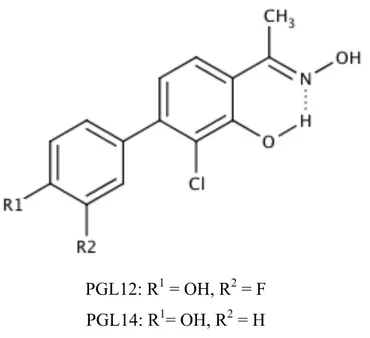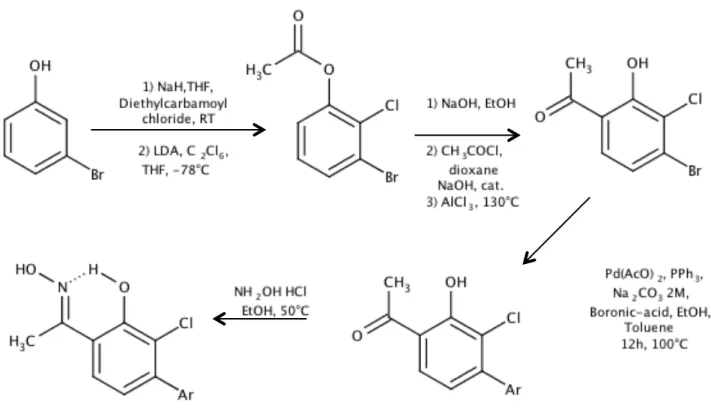UNIVERSITÁ DI PISA
DIPARTIMENTO DI FARMACIA
Corso di Laurea Specialistica in Chimica e Tecnologia Farmaceutiche
Tesi di Laurea
:
GLUT1-INHIBITORS: SYNTHESIS AND
ANALYSIS OF LIGAND-RECEPTOR INTERACTIONS
Relatori:
Prof. Filippo Minutolo
Dr. Tiziano Tuccinardi
Dr.ssa Carlotta Granchi
Candidato: Jessica Iegre (Matricola n° 423676)
Settore Scientifico Disciplinare: CHIM-08
The family of glucose transporters (GLUTs) embraces a group of isoforms of trans-membrane channel-proteins which allows the entry of D-glucose into the cells. These isoforms differ for
localization and for substrate affinity. Isoform GLUT-1 was the object of this thesis, since it was found to be overexpressed in carcinoma cells, and it is the main responsible for the entrance of D-glucose into the central nervous system. The over-expression of this protein on
the tumor cells membranes allows this type of cells to accumulate and use a large amount of D
-glucose and, consequently, to produce enough energy for their survival. In fact, tumor cells predominantly produce energy by a high rate of glycolysis, followed by lactic acid fermentation in the cytosol, rather than by a comparatively low rate of glycolysis followed by oxidation of pyruvate in mitochondria, such as that occurring in most normal cells. This metabolic switch is known as the Warburg Effect. Thus, selective inhibitors of GLUT1, may represent valid anticancer agents that selectively counteract tumor glycolysis.
So far, several molecules have been reported to be able to block glucose uptake. Most of them are natural molecules such as flavonoids, flavones, chalcones, but there are also examples of synthetic molecules, such as tamoxifen, fulvestrant, 17-β-estradiol. The interesting thing is that the majority of these molecules are also active on estrogen receptor beta (ERβ). Based on this concept, some salycilaldoxime and salicylketoxime derivatives, that had been previously designed and synthetized as potential ERβ-ligands in the research group where I have carried out my thesis project, were also tested in cellular assays on GLUT-1, and some of them displayed good inhibitory activities on glucose uptake.
The recent crystallization (resolution 2.9 Å) of the xylose transporter of E. Coli, XyLE, coordinated with D-glucose provided a valid starting point for a more accurate analysis of
human GLUT1 and to study the putative interaction modes of the most active salycilketoxime molecules and flavonoids. This transporter is formed by 492 amino acids and its folder was carried out with the homology model made with online server HHpred. This model showed that protein GLUT1 is formed by 12 transmembranes and 4 intracellular helices and both the N-terminus and C-N-terminus are located in the intracellular part of the protein. The aqueous channel seems to be divided into two parts by two residues that form a gate in the middle of the channel: Trp388 and His154. The homology model so obtained was inserted in a lipid bilayer of 1-palmitoyl-2-oleoyl-sn-glycero-3-phosphocholine (POPC) built with software VMD to simulate the biological environment. The resulting complex underwent a molecular dynamic simulation using AMBER 11, to remove all the constraints given by the crystallization process
and to evaluate conformational changes that happened when the complex was heated. As the complex was refined, the analysis of the putative binding sites for D-glucose, for the most
active ketoximes PGL12 and PGL14 (Figure 1), and for flavonoid Myrcetin was carried out with docking programs GOLD and GLIDE. This analysis gave three putative binding sites: one situated in the extracellular portion of the channel, one situated in the middle of the channel and the last one located between the intracellular helices of the protein. The best binding pose for each ligand in each putative binding site was submitted to a molecular dynamic simulation to evaluate the interactions energy (using the AMBER 11 functionality MMPB(GB)SA) and the hydrogen bonds (using AMBER 11 functionality PTRAJ). The trajectories resulting from the dynamic process were also analysed with USCF CHIMERA to evaluate hydrophobic interaction. From the crossing of all these results, the best putative binding site for all the studied inhibitors was the intracellular site. A steered molecular dynamic simulation was also run to evaluate the putative pathway of D-glucose through the channel.
Considering the pharmacophoric features required to have a good inhibitory activity on GLUT1, some substitutions were made on the starting hits PGL12 and PGL14 to evaluate how these changes might influence the inhibitory activity.
PGL12: R1 = OH, R2 = F PGL14: R1= OH, R2 = H
Figure 1. Salicylketoxime GLUT1-inhibitors PGL12 and PGL14
My project was dedicated to study the introduction of various substituents in the phenolic ring. The synthesis of these analogues started from commercial product 3-bromophenol, which was carbamoylated on the hydroxyl group. Then, a remarkably regioselective ortho-lithiation process, followed by a quenching with hexachloroethane, produced the insertion of a chlorine atom in position 2. The corresponding 2-chloro-3-bromo-carbamoylphenol was hydrolysed under basic conditions, to obtain 3-bromo-2-chloro-phenol. This molecule was acetylated and than the acetyl group was transposed by a Fries rearrangement reaction to afford 3-bromo-2-chloro-6-acetylphenol. This molecule underwent a cross-coupling reaction under Suzuki conditions using different boronic-acids to obtain variously substituted ketone intermediates. The metoxy group, if present in the aryl substituent, was deprotected with BBr3 in CH2Cl2 and the ketone group was finally transformed into the desired ketoxime . (Figure 2.)

